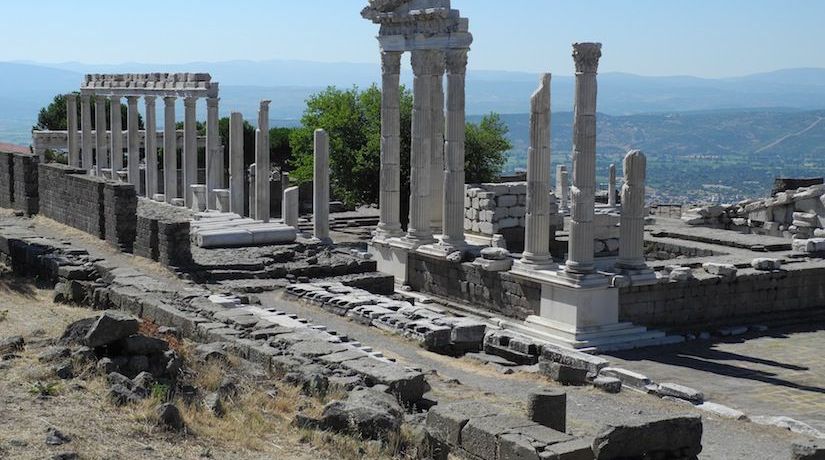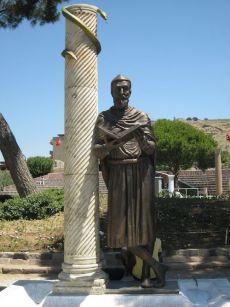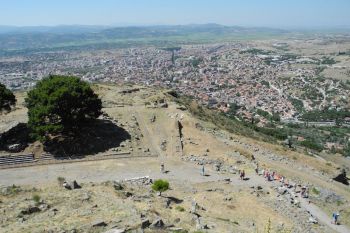The church of Pergamos, or Pergamum, received a message from Jesus Christ at the end of the first century. What did it mean? What does it mean for us?

Ruins of the temple of Trajan at Pergamos. Roman citizens had to offer incense to the emperor once each year, for which they were given a certificate showing they had complied with their civic duty. This temple was one place where this could be accomplished (photo by Joel Meeker).
As previously noted in this series of articles, the apostle John recorded in the book of Revelation a vision he received from Jesus Christ at the end of the first century. This vision included messages to seven congregations of the Church of God in Asia Minor. The church of Pergamos was one of these congregations (Revelation 1:11).
In this article we will consider the history of the city of Pergamos at the time the message was delivered and during subsequent centuries, the message Christ sent to them and the message’s significance for us today.
History of Pergamos
Founded by Greek colonists several centuries before the time of Christ, the city of Pergamos was located in the Caicus valley, approximately 50 miles north of Smyrna and about 15 miles inland from the Aegean Sea. Even though it was unable to rival Ephesus and Smyrna in terms of travel and commerce, it excelled in other areas.
Pergamos served as the capital city of the Greek dynasty of Attalid kings. “Eumenes II (197-159 B.C.) was the most illustrious king of the dynasty, and during his reign the city reached its greatest height. Art and literature were encouraged, and in the city was a library of 200,000 volumes (which later Antony gave to Cleopatra).
A modern statue of Asclepius from the Asclepium in Pergamos. Notice the snake, which was a symbol associated with Asclepius. This symbol continues to represent medical fields today (photo by Joel Meeker).
When the kingdom became Roman, Pergamos was named the capital of the province. In addition to providing government for the region, the city was a religious center. Beautiful temples were erected in honor of four pagan gods: Zeus, Dionysus, Athena and Asclepius. Asclepius was the mythological god of healing, and it is interesting to note that the serpent-entwined staff associated with him continues today as a symbol for modern medical arts.
“To the temple of [Asclepius], invalids from all parts of Asia flocked, and there, while they were sleeping in the court, the god revealed to the priests and physicians by means of dreams the remedies which were necessary to heal their maladies. Thus opportunities of deception were numerous. There was a school of medicine in connection with the temple. …
“Smyrna, a rival city, was a commercial center, and as it increased in wealth, it gradually became the political center. Later, when it became the capital, Pergamos remained the religious center” (ibid.).
Located in modern Turkey, Pergamos is now called Bergama. Among the ruins of the ancient city, which were excavated by the German government from 1879 to 1886, one can see the base of the altar of Zeus, a theater, the agora, a gymnasium and several temples.
Message to Pergamos
Christ’s message to this congregation was: “I know your works, and where you dwell, where Satan’s throne is. And you hold fast to My name, and did not deny My faith even in the days in which Antipas was My faithful martyr, who was killed among you, where Satan dwells.
“But I have a few things against you, because you have there those who hold the doctrine of Balaam, who taught Balak to put a stumbling block before the children of Israel, to eat things sacrificed to idols, and to commit sexual immorality. Thus you also have those who hold the doctrine of the Nicolaitans, which thing I hate.
“Repent, or else I will come to you quickly and will fight against them with the sword of My mouth. He who has an ear, let him hear what the Spirit says to the churches. To him who overcomes I will give some of the hidden manna to eat. And I will give him a white stone, and on the stone a new name written which no one knows except him who receives it” (Revelation 2:13-17).
Key points of the message
The foundation of the altar of Zeus, the vestiges of which were taken to Berlin in the 1800s (photo by Joel Meeker).
It is also significant to note that the reference to “Satan’s throne” indicates that Satan has a government here on earth. He is indeed the god of “this present evil age” (Galatians 1:4), “the prince of the power of the air” (Ephesians 2:2) and the being who could offer Jesus “all the kingdoms of the world and their glory” if Jesus would worship him (Matthew 4:8-9).
In stating, “And you hold fast to My name, and did not deny My faith even in the days in which Antipas was My faithful martyr” (Revelation 2:13), Jesus commended the church of Pergamos for remaining faithful to Him. Although surrounded by pagan worship, influence and pressure to conform to the society around them, they had remained obedient to God.
Smith’s Bible Dictionary states that, according to tradition, Antipas was the bishop of Pergamos prior to 100 A.D. (“Antipas”). In His message to the church at Pergamos, Christ tells them that He knew that this faithful man from their church had been martyred.
Even though members at Pergamos had held to the faith, Christ also told them that there were a few things of which some of them needed to repent. Specifically, Christ said that there were some who held “the doctrine of Balaam” and “the doctrine of the Nicolaitans” (verses 14-15).
The “doctrine of Balaam” refers to this man’s misguided attempt to try to serve God while also fulfilling his own personal interests—which were counter to God’s—as ancient Israel marched towards Canaan (Numbers 22-24). The point is: God expects us to obey Him fully, with our whole hearts (Deuteronomy 6:5; Psalm 119:2; Matthew 22:37). To learn more about why Balaam’s conduct remained as an enduring example of how not to worship God, see the article “Balaam” on this website.
The “doctrine of the Nicolaitans” (Revelation 2:15) is not precisely explained in Scripture. Based on its usage here and previously in the message to Ephesus (verse 6), it is clear that this doctrine is something God hates. The wording in verse 15 can be taken as implying that this doctrine is the same as “the doctrine of Balaam” or similar to “the doctrine of Balaam.”
Application today
Like all of the messages to the churches, Jesus concludes His message to Pergamos by admonishing readers to heed the messages given to all seven of the churches. So what can we learn from this message to Pergamos?
A key lesson for us is that we must resist Satan’s influence, even to the death, if necessary. Satan is a powerful spirit being who deceives the whole world (Revelation 12:9). He and his demons present themselves as “ministers of righteousness” (2 Corinthians 11:14-15) as they misrepresent God and His way of life. He, his cohorts and the world entice us to compromise our whole-hearted worship of God.
With the assistance of God’s Word and the Holy Spirit, Christians can successfully resist Satan and the world’s misguided thinking. If you are ready to commit to the life God wants you to lead, take action now:
- The articles found in the “Change” section of this website provide excellent guidance in making necessary changes.
- Additionally, attending a church that teaches the Christianity Jesus and the first-century apostles taught and practiced will accelerate your growth and provide fellowship with those of like mind. We can assist you in finding a congregation of the Church of God, a Worldwide Association, near you.
Remember that we are here to help you develop your relationship with God so you can eventually become part of His eternal family. Feel free to contact us to let us know how we can help.





